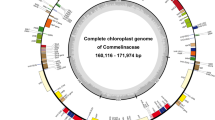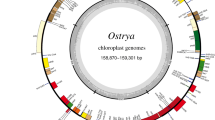Abstract
This study is focused on the Tehuacán-Cuicatlán Valley (Oaxaca, Mexico), which has a high diversity of Opuntia species whose phylogenetic relationships and chromosome numbers are mostly unknown. We aimed to investigate the phylogenetic position of Opuntia tehuacana and its sympatric species and to analyze the ploidy levels in five O. tehuacana localities. We performed phylogenetic analysis under Bayesian inference using three chloroplast markers (matK, ycf1 and psbJ-petA) and two nuclear introns (AT3G48380 and AT1G18270) as well as chromosome counts for three Opuntia species and flow cytometry analysis in O. tehuacana. In a broad phylogenetic context, O. tehuacana is a member of the Basilares clade, as are most of its sympatric species, except for Opuntia decumbens, Opuntia lasiacantha, and Opuntia huajuapensis, which are in the Nopalea clade. The comparison between nuclear and plastid trees showed incongruences for the positions of the eight analyzed Opuntia species, although the O. tehuacana clade was recovered by both analyses. Furthermore, the phylogeny of nuclear evidence showed a geographic structure congruent with the sampled localities for O. tehuacana. The ploidy levels of O. tehuacana are 11x and 12x, the highest reported thus far for the genus, whereas for Opuntia pilifera it is 8x and for O. huajuapensis it is 2x. Finally, we found that the significant differences among O. tehuacana genome sizes and the high ploidy level might be due to multiple polyploidization events occurring between individuals from the same species and involving other Opuntia species.






Similar content being viewed by others
References
Anderson EF (2001) The cactus family. Timber Press, Portland, Oregon
Arias S, Gama S, Vázquez B, Guzmán LU (2012) Flora del valle de Tehuacán-Cuicatlán. Fascículo 95, Cactaceae. Instituto de Biología, Universidad Nacional Autónoma de México 95
Arnold ML (1997) Natural hybridization and evolution. Oxford University Press, Nueva York
Baker M, Pinkava D (2018) Chromosome numbers in some cacti of western North America IX. Haseltonia 25:2–29
Baker MA, Rebman JP, Parfitt BD et al (2009) Chromosome numbers in some cacti of western North America-VIII. Haseltonia 15:117–134
Barke BH, Karbstein K, Daubert M, Hörandl E (2020) The relation of meiotic behaviour to hybridity, polyploidy and apomixis in the Ranunculus auricomus complex (Ranunculaceae). BMC Plant Biol 20:523
Barthlott W, Burstedde K, Geffert JL, et al (2015) Biogeography and biodiversity of cacti. Schumannia, Alemania
Biémont C (2008) Within-species variation in genome size. Heredity 101:297–298
Bravo-Hollis H (1978) Las cactáceas de México. Universidad Nacional Autónoma de México
Bustamante E, Búrquez A, Scheinvar E, Eguiarte LE (2016) Population genetic structure of a widespread bat-pollinated columnar cactus. PLoS ONE 11:e0152329. https://doi.org/10.1371/journal.pone.0152329
Chen ZJ, Ha M, Soltis D (2007) Polyploidy: genome obesity and its consequences. New Phytol 174:717–720
Cid R, Palomino G (1996) Cytotypes and Meiotic Behavior in Mexican Populations of Myrtillocactus geometrizans var. geometrizans (Cactaceae). Cytologia 61:343–348
Darriba D, Taboada GL, Doallo R, Posada D (2012) jModelTest 2: more models, new heuristics and parallel computing. Nat Methods 9:772. https://doi.org/10.1038/nmeth.2109
De Storme N, Mason A (2014) Plant speciation through chromosome instability and ploidy change: cellul ar mechanisms, molecular factors and evolutionary relevance. Curr Plant Biol 1:10–33
Del Angel C, Palomino G, García A, Méndez I (2006) Nuclear genome size and karyotype analysis in Mammillaria species (Cactaceae). Caryologia 59:177–186
Doležel J, Greilhuber J, Suda J (2007) Estimation of nuclear DNA content in plants using flow cytometry. Nat Protocols 2:2233–2244
Doležel J, Čížková J, Šimková H, Bartoš J (2018) One major challenge of sequencing large plant genomes is to know how big they really are. Int J Mol Sci 19:3554. https://doi.org/10.3390/ijms19113554
Doyle JJ, Doyle JL (1987) A rapid DNA isolation procedure for small quantities of fresh leaf tissue. Phytochemical Bulletin 19:11–15
Edgar RC (2004) MUSCLE: multiple sequence alignment with high accuracy and high throughput. Nucleic Acids Res 32:1792–1797
Eilam T, Anikster Y, Millet E et al (2010) Genome size in diploids, allopolyploids, and autopolyploids of mediterranean Triticeae. J Bot 2010:e341380. https://doi.org/10.1155/2010/341380
Granados-Aguilar X, Granados Mendoza C, Cervantes CR et al (2021) Unraveling reticulate evolution in Opuntia (Cactaceae) from Southern Mexico. Front Plant Sci 11:606809. https://doi.org/10.3389/fpls.2020.606809
Griffith PM (2001) Experimental hybridization of northern Chihuahuan Desert region Opuntia (Cactaceae). Aliso 20:37–42
Griffith PM, Porter M (2009) Phylogeny of Opuntioideae (Cactaceae). Int J Plant Sci 170:107–116
Henry IM, Dilkes BP, Tyagi AP et al (2009) Dosage and parent-of-origin effects shaping aneuploid swarms in A. thaliana. Heredity 103:458–468
Hunt DR, Taylor NP, Charles G (2006) The new cactus lexicon: Text. DH Books, Milborne Port, England
Huson DH, Scornavacca C (2012) Dendroscope 3: An interactive tool for rooted phylogenetic trees and networks. Syst Biol 61:1061–1067
Lawrence EM (1985) Senecio L. (Asteraceae) in Australia: recombination systems of a polyploid series. Aust J Bot 33:209–219
Leitch IJ, Bennett MD (2004) Genome downsizing in polyploid plants. Biol J Linn Soc 82:651–663
Letunic I, Bork P (2007) Interactive Tree of life (iTOL): an online tool for phylogenetic tree display and annotation. Bioinformatics 23:127–128
Majure LC, Puente R (2014) Phylogenetic relationships and morphological evolution in Opuntia s. str. and closely related members of tribe Opuntieae. Further studies in the Opuntioideae (Cactaceae), D. Hunt. DH Books, UK, pp 9–30
Majure LC, Judd WS, Soltis PS, Soltis DE (2012a) Cytogeography of the Humifusa clade of Opuntia s.s. Mill. 1754 (Cactaceae, Opuntioideae, Opuntieae): correlations with pleistocene refugia and morphological traits in a polyploid complex. Comp Cytogenet 6:53–77
Majure LC, Puente R, Griffith MP et al (2012b) Phylogeny of Opuntia s.s. (Cactaceae): clade delineation, geographic origins, and reticulate evolution. Am J Bot 99:847–864
Majure LC, Puente R, Pinkava DJ (2012c) Miscellaneous chromosome numbers in Opuntieae Dc. (Cactaceae) with a compilation of counts for the group. Haseltonia 18:67–78
Martínez J, Mendez I, Palomino G (2000) Cytological and genical differentiation between cytotypes of Echeandia nana (Anthericaceae). Caryologia 53:147–158
Meng J, Fougere-Danezan M, Zhang L-B et al (2011) Untangling the hybrid origin of the Chinese tea roses: evidence from DNA sequences of single-copy nuclear and chloroplast genes. Plant Syst Evol 297:86–101
Mestiri I, Chagué V, Tanguy A-M et al (2010) Newly synthesized wheat allohexaploids display progenitor-dependent meiotic stability and aneuploidy but structural genomic additivity. New Phytol 186:86–101
Müller J, Müller K, Neinhuis C, Quandt D (2005) PhyDE® - phylogenetic data editor
Naumann J, Symmank L, Samain M-S, Müller KF, Neinhuis C, dePamphilis CW et al (2011) Chasing the hare - evaluating the phylogenetic utility of a nuclear single copy gene region at and below species level within the species rich group Peperomia (Piperaceae). BMC Evol Biol 11:357. https://doi.org/10.1186/1471-2148-11-357
Nobel PS, Bobich EG (2002) Environmental biology. In: Nobel PS (ed) Cacti: biology and uses. University of California Press, California, pp 57–74
Nodal-Moreno SA, Palomino G, Almaguer-Sierra P, et al (2019) Análisis del tamaño del genoma, poliploidía y patrón endopoliploide en poblaciones de Nopalea cochenillifera (L.) Salm-Dyck (Cactaceae) en Tamaulipas, México. Acta universitaria 29. https://doi.org/10.15174/au.2019.2238
Otto F (1990) Chapter 11 DAPI staining of fixed cells for high-resolution flow cytometry of nuclear DNA. Flow cytometry. Elsevier, pp 105–110. https://doi.org/10.1016/S0091-679X(08)60516-6
Palomino G, Vázquez R (1991) Cytogenetic studies in Mexican populations of species of Crotalaria L. (Leguminosae-Papilionoideae). Cytologia 56:343–351
Palomino G, Martínez J, Méndez I et al (2016) Nuclear genome size, ploidy level and endopolyploidy pattern in six species of Opuntia (Cactaceae). Caryologia 69:82–89
Pinkava DJ (2002) On the evolution of the North American opuntioideae. Studies in the Opuntioideae (Cactaceae), D. Hunt. DH Books, pp 59–98
Powell AM, Weedin JF (2001) Chromosome numbers in Chihuahuan Desert Cactaceae. III Trans-Pecos Texas Am J Bot 88:481–485
Rieseberg LH (1991) Homoploid reticulate evolution in Helianthus (Asteraceae): Evidence from ribosomal genes. Am J Bot 78:1218–1237
Rieseberg L, Soltis D (1991) Phylogenetic consequences of cytoplasmic gene flow in plants. Evol Trend Plant 5:65–84
Ronquist F, Huelsenbeck JP (2003) MrBayes 3: Bayesian phylogenetic inference under mixed models. Bioinformatics 19:1572–1574
Russell A, Samuel R, Klejna V et al (2010) Reticulate evolution in diploid and tetraploid species of Polystachya (Orchidaceae) as shown by plastid DNA sequences and low-copy nuclear genes. Ann Bot 106:37–56
Sang T, Zhang D (1999) Reconstructing hybrid speciation using sequences of low copy nuclear genes: hybrid origins of five Paeonia species based on Adh gene phylogenies. Syst Bot 24:148–163
Soltis DE, Soltis PS (1999) Polyploidy: recurrent formation and genome evolution. Trends Ecol Evol 14:348–352
Soltis DE, Soltis PS, Tate JA (2003) Advances in the study of polyploidy since plant speciation. New Phyt 161:173–191
Stebbins GL (1971) Chromosomal evolution in higher plants. Edward Arnold Publishers, Londres
Team R. Core (2013) R: a language and environment for statistical computing
Walker DJ, Moñino I, González E et al (2005) Determination of ploidy and nuclear DNA content in populations of Atriplex halimus (Chenopodiaceae). Bot J Linn Soc 147:441–448
Wang Z, Du S, Dayanandan S et al (2014) Phylogeny reconstruction and hybrid analysis of Populus (Salicaceae) based on nucleotide sequences of multiple single-copy nuclear genes and plastid fragments. PLoS ONE 9:e103645. https://doi.org/10.1371/journal.pone.0103645
Wu J-H, Datson PM, Manako KI, Murray BG (2014) Meiotic chromosome pairing behaviour of natural tetraploids and induced autotetraploids of Actinidia chinensis. Theor Appl Genet 127:549–557
Yuasa H, Shimizu H, Kashiwai S, Kondo N (1974) Chromosome numbers and their bearing on the geographic distribution in the subfamily Opuntioideae (Cactaceae). Rep Inst Breed Res 4:1–10
Acknowledgements
This article is part of the doctoral research of X. Granados, who thanks the graduate program Doctorado en Ciencias Biológicas, Universidad Nacional Autónoma de México, and the scholarships provided by Consejo Nacional de Ciencia y Tecnología. We thank Yolanda Morales, Daniel Franco, Brenda Calderón, and Cristian Cervantes (Jardín Botánico, UNAM) for supporting the field work, Ulises Rosas and Andrea R. Jiménez (Jardín Botánico and Instituto de Biología, UNAM) for their support in molecular laboratory work, Miriam Ladd Otero for her support in flow cytometry work at Jardín Botánico, UNAM, Andrea Bedoya López and Evelyn Alvarez (Laboratorio Nacional de Citometría de Flujo) for their support in flow cytometry work, Jaroslav Dolezel (Institute of Experimental Botany, Czech Republic) for kindly providing control seeds for flow cytometry studies, the Laboratorio Nacional de Citometría de Flujo (LABNALCIT) at Instituto de Investigaciones Biomédicas, UNAM, and the LANABIO laboratories at Jardín Botánico and Instituto de Biología, UNAM. This contribution was financially supported by UNAM-DGAPA-PAPIIT <IN208619> Granted to S. A.
Author information
Authors and Affiliations
Contributions
All authors contributed to the study conception and design. XG-A helped in investigation, formal analysis, methodology, writing of the original draft, text revision, and editing. GP contributed to methodology conceptualization, text revision, and editing. JM-R performed methodology conceptualization, formal analysis, text revision, and editing. SA is a researcher leading this study and obtaining financial support. All of the authors approved the submitted version of this manuscript.
Corresponding authors
Ethics declarations
Conflict of interest
The authors declare that they have no conflict of interest.
Additional information
Publisher's Note
Springer Nature remains neutral with regard to jurisdictional claims in published maps and institutional affiliations.
Supplementary Information
Below is the link to the electronic supplementary material.
Rights and permissions
Springer Nature or its licensor holds exclusive rights to this article under a publishing agreement with the author(s) or other rightsholder(s); author self-archiving of the accepted manuscript version of this article is solely governed by the terms of such publishing agreement and applicable law.
About this article
Cite this article
Granados-Aguilar, X., Palomino, G., Martínez-Ramón, J. et al. Genome evolution and phylogenetic relationships in Opuntia tehuacana (Cactaceae, Opuntioideae). Braz. J. Bot 45, 957–969 (2022). https://doi.org/10.1007/s40415-022-00821-4
Received:
Revised:
Accepted:
Published:
Issue Date:
DOI: https://doi.org/10.1007/s40415-022-00821-4




